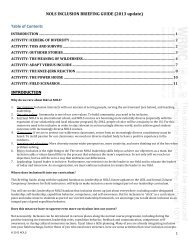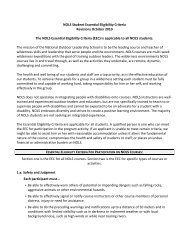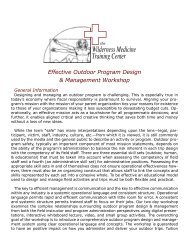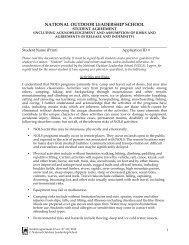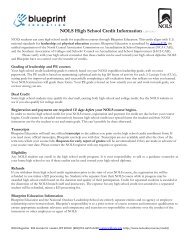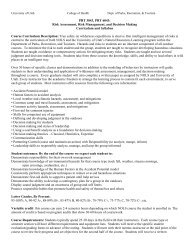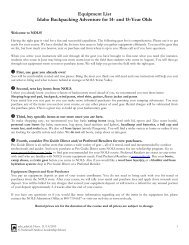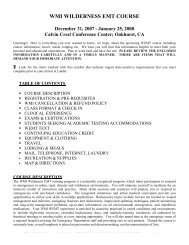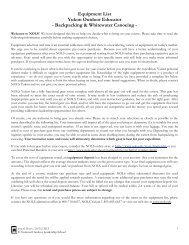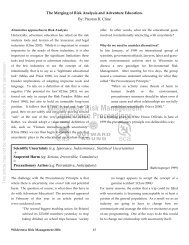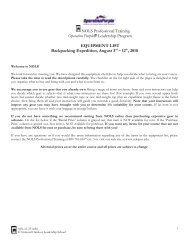introduction to the 2008 nols leadership educator notebook
introduction to the 2008 nols leadership educator notebook
introduction to the 2008 nols leadership educator notebook
Create successful ePaper yourself
Turn your PDF publications into a flip-book with our unique Google optimized e-Paper software.
LEADERSHIP EDUCATION AT NOLSHISTORICAL BACKGROUNDPaul Petzoldt, founder of <strong>the</strong> National Outdoor LeadershipSchool (NOLS), recognized that <strong>the</strong> wilderness itself teaches <strong>leadership</strong>.Petzoldt saw that in <strong>the</strong> wild, people learn <strong>to</strong> master whatthings <strong>the</strong>y can control, and <strong>the</strong>y learn <strong>to</strong> live in rhythm with <strong>the</strong>things <strong>the</strong>y cannot.Petzoldt passionately believed that NOLS must teach <strong>leadership</strong>using real experiences. Upon starting <strong>the</strong> school he said, “We have<strong>to</strong> have something that is real: like climbing mountains, like fordingwild rivers, like exploring wild country, like facing <strong>the</strong> s<strong>to</strong>rms, likesurviving in <strong>the</strong> wilderness.” With clear and tangible course goals,instruc<strong>to</strong>rs create <strong>the</strong>se real experiences that are <strong>the</strong> foundation ofNOLS’ <strong>leadership</strong> education.Natural ConsequencesIn <strong>the</strong> wilderness, physical feedback from decisions or actions isoften immediate, sometimes raw, and usually quite accurate. Sometimesfeedback takes <strong>the</strong> form of an uncomfortable night becausestudents didn’t look after <strong>the</strong>ir equipment in <strong>the</strong> rain. Sometimesit’s a feeling of uncommon unity after <strong>the</strong>y work <strong>to</strong>ge<strong>the</strong>r <strong>to</strong> travelthrough thigh-deep snow.Experience alone, however, does not evoke better <strong>leadership</strong>. Petzoldtsaid, “All my life I have had <strong>to</strong> fight against <strong>the</strong> myth, <strong>the</strong> oldwives tale, that you develop judgment from experience. A personcan be in <strong>the</strong> outdoors for years and repeat <strong>the</strong> same mistakes timeafter time.”ReflectionFor raw experience <strong>to</strong> ripen in<strong>to</strong> <strong>leadership</strong> growth, our studentsmust understand and learn from <strong>the</strong> consequences of <strong>the</strong>ir actions.It is critical that <strong>the</strong>y reflect upon and discuss <strong>the</strong>ir experiences sothat <strong>the</strong>y may determine what <strong>to</strong> repeat and what <strong>to</strong> change. Theymust practice and expand <strong>the</strong>ir <strong>leadership</strong> skills.Character EducationThe character of a group’s leaders and members will ei<strong>the</strong>r aidit in, or prevent it from, accomplishing its goals. Individuals need<strong>to</strong> develop <strong>the</strong>ir own character by applying values, not just talkingabout <strong>the</strong>m. True character is walking <strong>the</strong> walk. Pla<strong>to</strong> said, “We obtainbetter knowledge of a person during one hour’s play and gamesthan by conversing with <strong>the</strong>m for a whole year.” We teach characterwhen we teach Expedition Behavior. This book also addresses characterin <strong>the</strong> section “The Waterline Model”.Role of NOLS Instruc<strong>to</strong>rsNOLS instruc<strong>to</strong>rs are guardians of <strong>the</strong> <strong>leadership</strong> learning processand teachers of new skills and knowledge. They create an environmentthat allows learning <strong>to</strong> happen naturally and safely. Theydon’t teach people a different way of being, <strong>the</strong>y create conditionssuch that students can discover <strong>the</strong>ir own natural <strong>leadership</strong>.TransferenceStudents at NOLS learn <strong>to</strong> appreciate things that many peopletry <strong>to</strong> avoid but which are necessary if <strong>the</strong>y are <strong>to</strong> lead: <strong>to</strong>lerance forambiguity and <strong>the</strong> unknown, <strong>to</strong>lerance for daunting challenge, <strong>to</strong>lerancefor <strong>the</strong>ir own and o<strong>the</strong>rs’ anxiety, <strong>to</strong>lerance for disapproval,<strong>to</strong>lerance for hard physical work and discomfort, and <strong>to</strong>lerance for<strong>the</strong>ir shared humanity. They experience <strong>the</strong> joy of meeting a challengewell, of creating a vibrant community, of living and travelingin <strong>the</strong> wild, and of appreciating and protecting <strong>the</strong> natural worldaround <strong>the</strong>m.Leadership skills learned at NOLS are life skills. The increasedself-assessment, competence, communication, expedition behavior,decision-making, judgment, initiative and <strong>to</strong>lerance for adversityand uncertainty transfer <strong>to</strong> <strong>leadership</strong> in all aspects of people’s lives.Integrated Teaching of Expeditionary LeadershipPetzoldt said, “We can only teach <strong>the</strong> things that a leader mustknow and we have <strong>to</strong> let slip by <strong>the</strong> wayside a hundred thousandthings that it would be nice for <strong>the</strong> leader <strong>to</strong> know. But by concentratingon things that <strong>the</strong> leader must know, by being sure that <strong>the</strong>leader has no dangerous blank spots in his learning, we [feel] that<strong>the</strong> National Outdoor Leadership School graduates are far safer andfar better qualified than all but a handful of o<strong>the</strong>r outdoor leaders in<strong>the</strong> United States.” (Petzoldt, 1974, p. 146.)LectureNew NOLS instruc<strong>to</strong>rs commonly teach <strong>leadership</strong> <strong>to</strong>pics usinga traditional lecture approach. Because of students’ typical “forgettingcurve,” instruc<strong>to</strong>rs should schedule <strong>the</strong>ir lectures as near in timeas possible <strong>to</strong> <strong>the</strong>ir pertinent applications. It is also critical that instruc<strong>to</strong>rsfacilitate reflection after key activities so students can seewhat actually mattered in <strong>the</strong>ir real life experience.Beginning staff rely heavily on this academic approach becauseit is easy. More advanced instruc<strong>to</strong>rs develop a knack for presentinginformation spontaneously and in <strong>the</strong>ir own voices. Seasoned instruc<strong>to</strong>rscan deliver <strong>the</strong> curriculum more powerfully and au<strong>the</strong>nticallysince <strong>the</strong>y speak with <strong>the</strong> conviction of <strong>the</strong>ir own experience.Experienced NOLS instruc<strong>to</strong>rs also personalize <strong>the</strong> <strong>to</strong>ne and conten<strong>to</strong>f this book’s s<strong>to</strong>ck outlines, and <strong>the</strong>y can better use lectures atspecific points in a course <strong>to</strong> augment <strong>the</strong>ir students’ experiences.According <strong>to</strong> our alumni, if <strong>the</strong>re is one area in <strong>the</strong> NOLS corecurriculum that “classes” are more important, it is <strong>leadership</strong>. The<strong>leadership</strong> progression, and our classes, are commented on routinelyas being helpful in not just learning <strong>leadership</strong>, but in applying it <strong>to</strong>life beyond NOLS (Sibthorp, <strong>2008</strong>).Planned experienceIt is possible <strong>to</strong> use a planned experience <strong>to</strong> teach a <strong>to</strong>pic. It workswell <strong>to</strong> follow <strong>the</strong> “describe, demonstrate, do, discuss” progression,telling students beforehand what <strong>the</strong>y can expect <strong>to</strong> learn. For instance,<strong>the</strong> first hiking day on a Wilderness Course is an obvioustime <strong>to</strong> teach “leader of <strong>the</strong> day” (LOD) skills. Tell students thatyou are modeling specific behaviors that <strong>the</strong>y will have <strong>to</strong> performwhen <strong>the</strong>y are leader of <strong>the</strong> day. Use a checklist <strong>to</strong> help you fill gapsin areas that don’t naturally arise during that hiking day. A <strong>the</strong> endof <strong>the</strong> day, review and ask <strong>the</strong> students if <strong>the</strong>y noticed you doingthose things. Consider a large-group discussion that includes all <strong>the</strong>hiking groups <strong>to</strong> compare notes that night. Some students mightlearn better if you have <strong>the</strong>m copy down written LOD expectations.You are now ready <strong>to</strong> ask students <strong>to</strong> practice <strong>the</strong>ir LOD skills <strong>the</strong>next day.<strong>2008</strong> NOLS Leadership Educa<strong>to</strong>r Notebook 5Introduction




